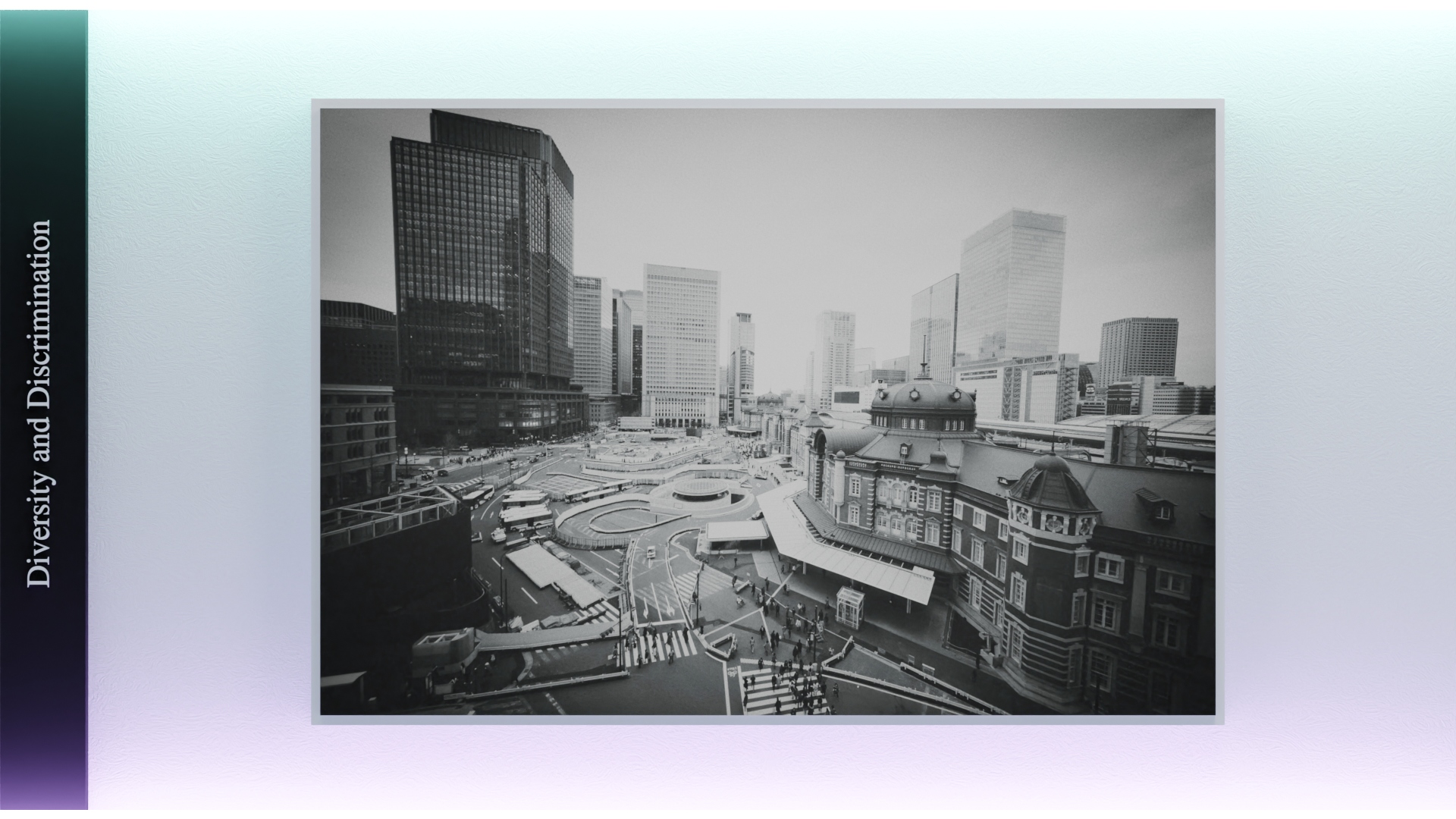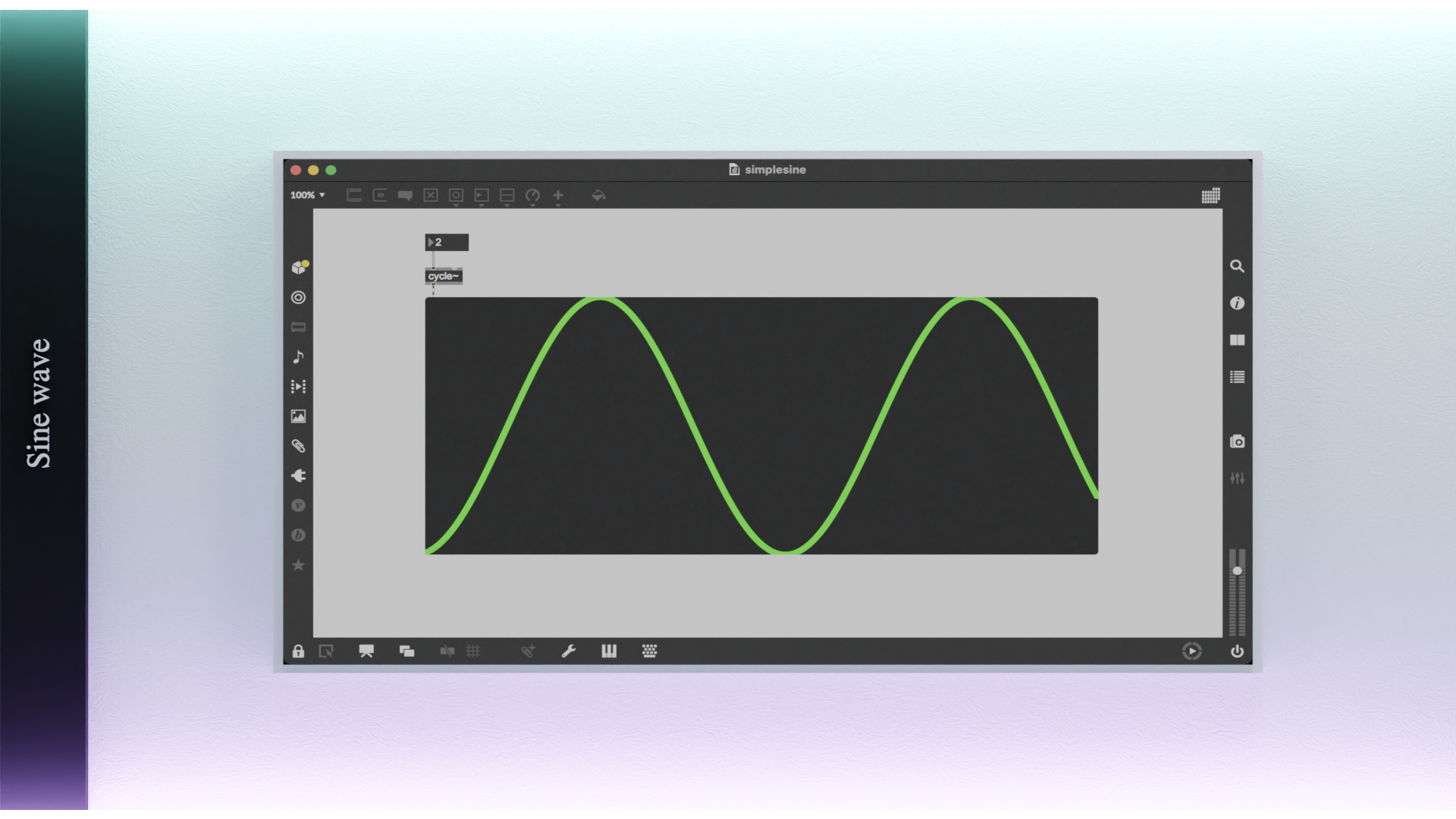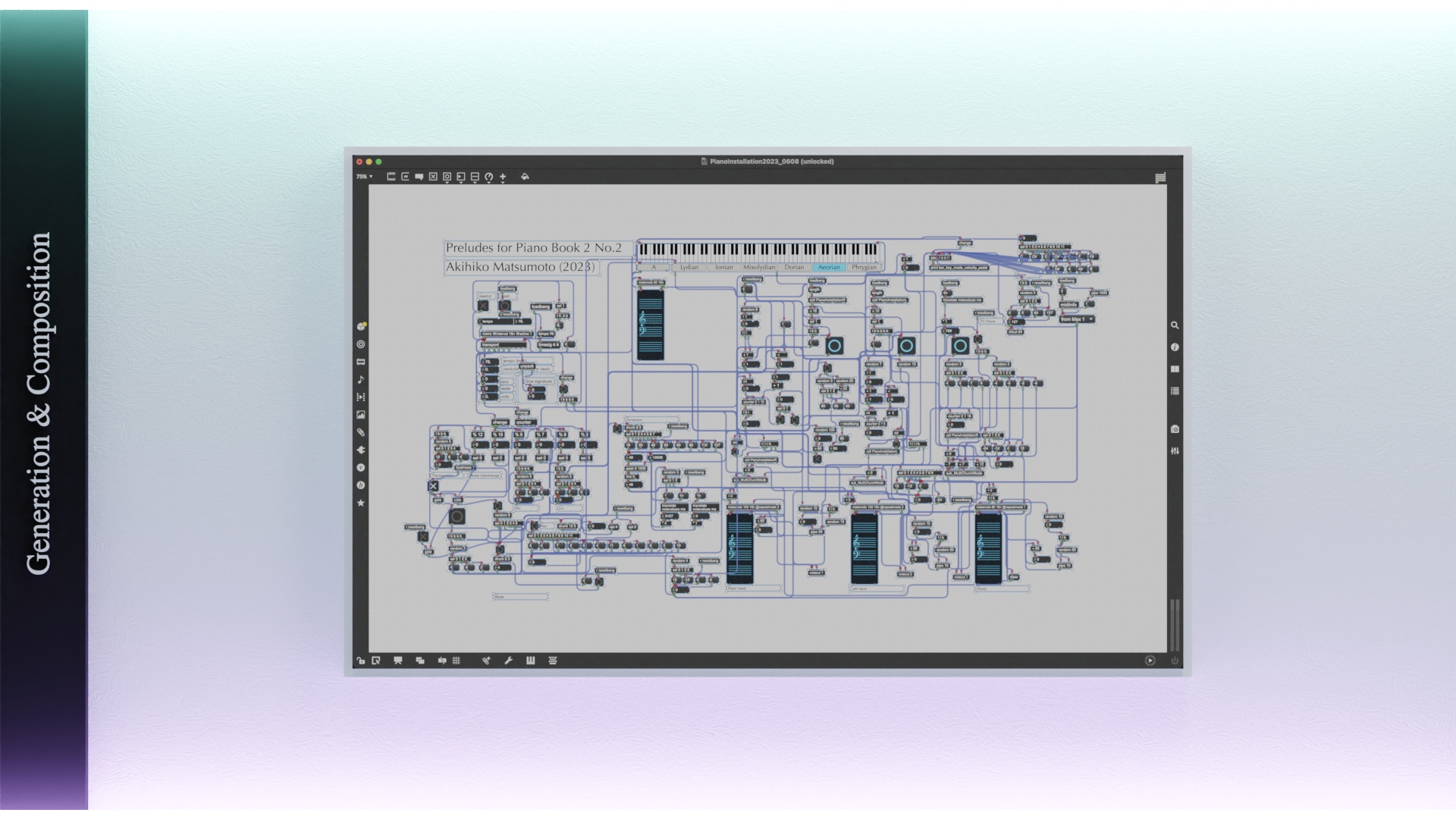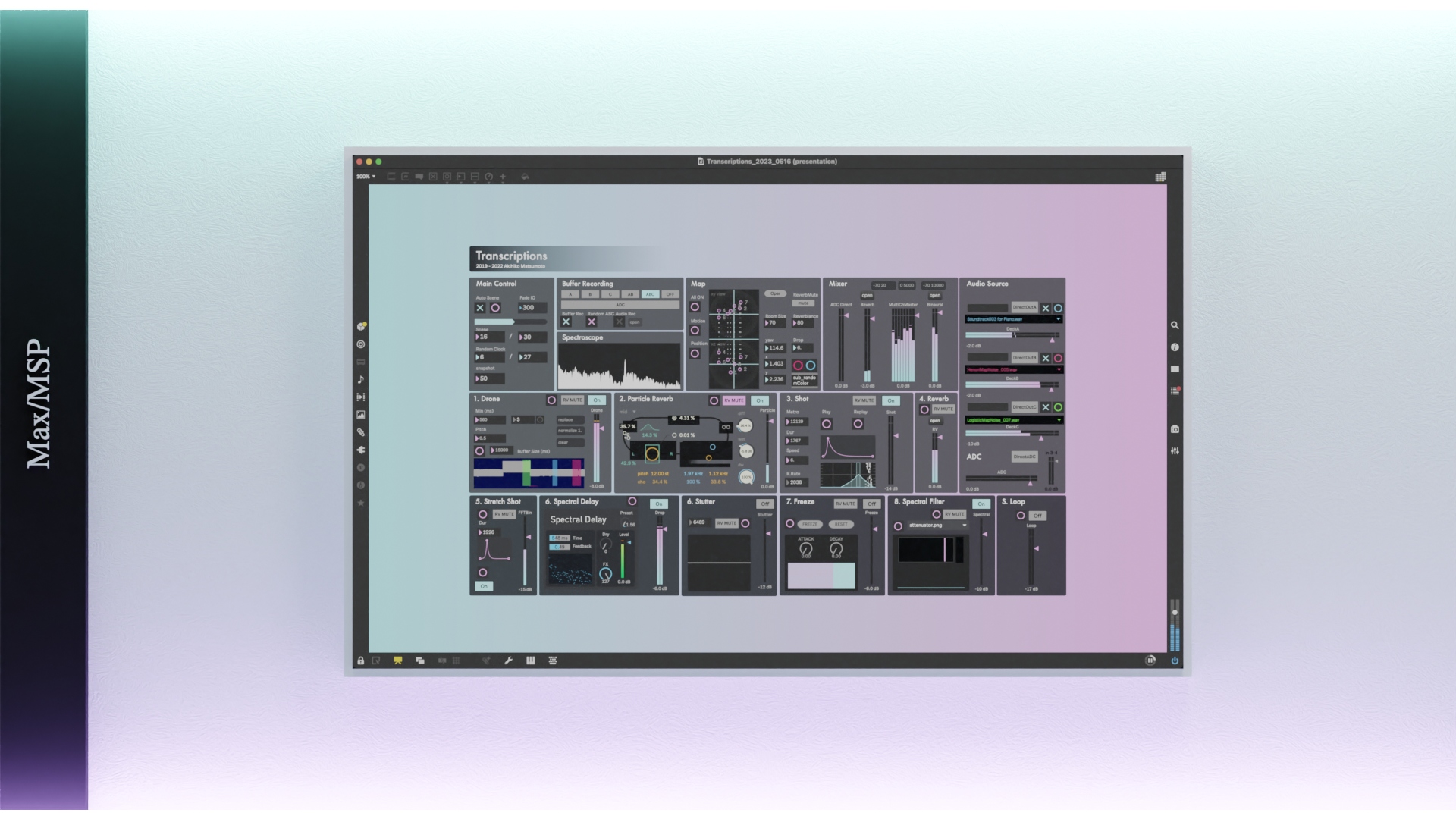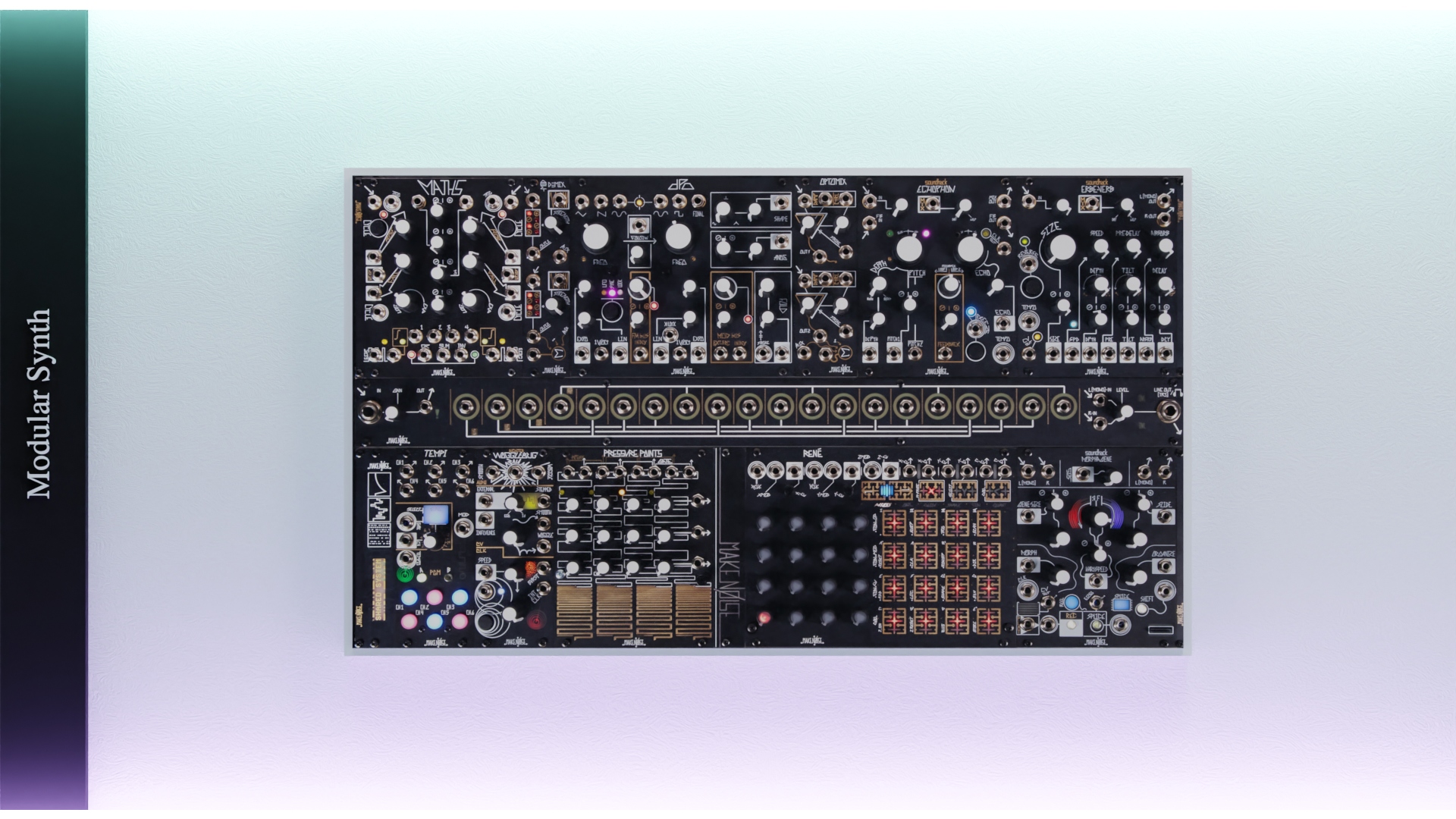
Noise
What comes to mind when you hear the word noise? Unwanted sound? Unpleasant sound? Unbeautiful sound? It
may be a characteristic of the 20th century that musicians and sound designers who reinvented the concept of
noise, which is often taken in a negative sense, and proactively used it as a material for expression,
appeared on the scene after electronic technology and recording technology developed, making it easier to
intentionally manipulate noise.
I believe that there is also potential in noise as a new material that has not yet been fully known like
other musical sounds.
The term "noise" is a difficult concept to define because it is so individual in its meaning. For some, the
sound from a washing machine may sound as beautiful as music, while for others, classical music may be
perceived as unpleasant noise.
It is no exaggeration to say that just as music has as many meanings as there
are people, so too does noise have as many meanings as there are people. Knowing noise may paradoxically
lead to a deeper understanding of sound and music.
Even artists in the noise music scene often do not like to be categorized as noise, and it is a sensitive
term for those who explore noise as a music rather than a counter-expression to music.
Since it would be difficult to collect noise in the humanities here, I would like to focus on noise in the
natural science sense for a moment and consider what noise is.
ノイズという言葉を聞いて何を思い浮かべるでしょうか。不要な音?不快な音?美しくない音?少なからずネガティブな意味で捉えられることも少なくないノイズという概念を再発明し、主体的に表現の素材にしてしまう音楽家やサウンドデザイナーが登場したのも20世紀に電子技術、録音技術が発達しノイズを意図的に操りやすくなってからの特徴かもしれません。
まだ他の楽音のように知り尽くされていない新素材としての可能性もノイズには眠っているのではないでしょうか。
ノイズという言葉はあまりに意味の捉え方に個人差があり、定義が難しい概念でもあります。ある人にとっては洗濯機から発せられる音が音楽のように美しく聴こえているかもしれませんし、またある人にとってはクラシック音楽が不快なノイズとして捉えられているかもしれません。
音楽の意味が人の数だけ存在するように、ノイズの意味もまた人の数だけ生じると言っても過言ではないでしょう。ノイズを知ることは逆説的に音や音楽をより深く知ることにつながるかもしれません。
ノイズミュージックと呼ばれる音楽シーン周辺にいるアーティストでもしばしば自分がノイズという括りをされることを嫌うケースもあり、音楽に対するカウンター表現ではなくあくまで音楽としてノイズを追求している人たちにとっては繊細な用語です。
ここでは人文科学的な意味のノイズを取り上げると収集がつかなくなってしまうので、一旦自然科学的な意味でのノイズに的を絞って、ノイズとは何かについて考えてみたいと思います。
What is noise
ノイズとは
Noise in the scientific sense can actually be generated in a simple way. It is to draw waveforms randomly. However, in a strict sense, it is somewhat difficult for humans to do things randomly, without bias and without repetition. That's why electronics and computers are useful. The video above uses a small modular synth called 0-Coast from Make Noise to create sound by giving commands at high speed to a point where a random voltage is generated. In terms of speed, this is several hundred times per second. Ideally, it should be tens of thousands of times, but such clock speeds did not drive the Make Noise synth. This is the only way to make noise. Try writing a program in Max/MSP that implements this principle as it is. There are many ways to implement it, such as drawing a waveform in a buffer or increasing or decreasing the clock rate of the rand~ object, but you will see that it is a very simple principle that can generate noise.
科学的な意味でのノイズは実は単純な方法で生成することができます。それは波形をランダムに描くということです。しかしながら厳密な意味で偏りなく繰り返すこともなくランダムに物事を実行するというのは人間には少々難しかったりします。 そこで電子機器やコンピューターの出番がやってきます。 上の映像はMake Noiseの0-Coastという小型のモジュラーシンセを使いランダムに電圧を生成する箇所に、高速に命令を与えることで音にしています。速度で言うと一秒間に数百回です。理想的には数万回は必要なのですが、そのようなクロックスピードではMake Noiseのシンセは駆動しませんでした。 これだけでノイズになります。 この原理をそのままMax/MSPでプログラムを書いて実行してみてください。実装の方法はバッファーに波形を描いたり、rand~オブジェクトのクロックレートを上げ下げしてみたり、いろいろあると思いますが、実に単純な原理でノイズを生み出せることがわかると思います。
Color Noise
カラーノイズ
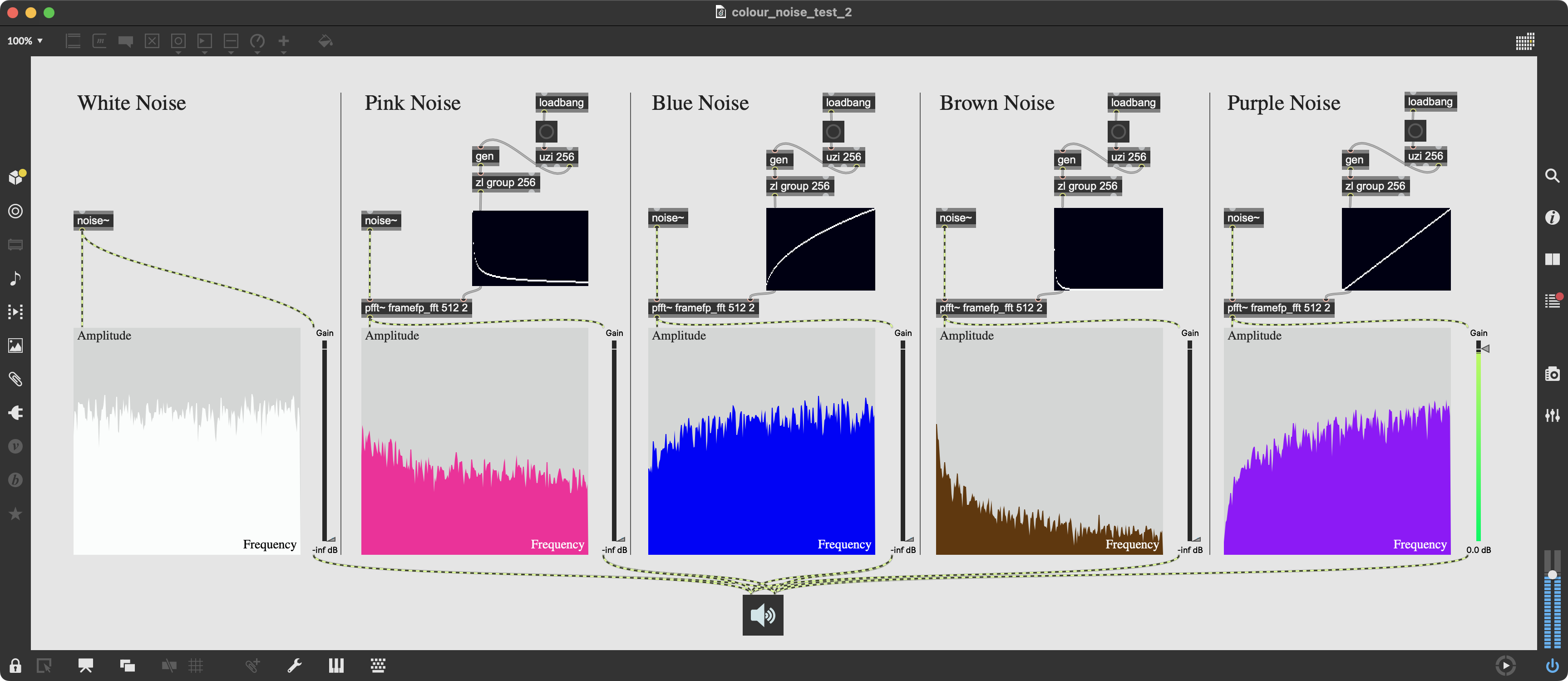
Download: Cycling '74 Max 8 Patch colornoise.maxpat
Special Thanks: Fendoap Link
Noise as a sound source is a very common material used in electronic sound design.
It is one of the most
basic sound materials, like a sine wave, without which sound design would be impossible, even when
simulating real-world acoustic instrument-like sounds such as the breath of a wind instrument or the attack
of a string or percussion instrument using electronic sounds.
Whether we are aware of it or not, the sounds emitted by many instruments contain momentary noise of
indistinct pitch that cannot be described as notes, and if the noise is removed, the familiar organic sounds
of the instruments instantly become unnatural.
It is also common to use noise as a modulation source and control synthesizer parameters with waveforms
created while processing noise.
Noise has often been associated with color and different characteristics of its frequency distribution from
low to high frequencies.
サウンドソースとしてのノイズは電子音を使ったサウンドデザインではごく一般的によく使われる素材です。
管楽器の息の音、弦楽器や打楽器のアタックの音など現実世界のアコースティック楽器のような音を電子音でシミュレーションするときにも、ノイズ無しにサウンドデザインをすることは不可能なほどサイン波のように最も基本的な音の素材の一つとなります。
意識しているかは別として、多くの楽器から発せられる音響には音符としては記述ができない不明瞭なピッチの瞬間的なノイズが含まれており、ノイズを抜いてしまうと聞き慣れた有機的な楽器の音も途端に不自然になってしまいます。
また、モジュレーションソースとしてノイズを利用し、シンセサイザーのパラメータをノイズを加工しながら作る波形でコントロールすることも一般的です。
そしてノイズはしばしばその低域から高域までの周波数分布の特長の違いを色と結びつけて使い分けられてきました。
White Noise
ホワイトノイズ
White noise is a sound that has the same power signal in all frequency bands from low to high frequencies and is also called white in sound because light, including all spectrums, is white light. In digital audio, if all the sample values to be drawn as a waveform are determined randomly, it becomes white noise.
ホワイトノイズは全ての低周波から高周波、つまり低い音から高い音まですべての周波数帯域で同じパワーの信号が入っている音で、全てのスペクトルを含む光が白色光であることから音でもホワイトと呼ばれます。 デジタルオーディオでは波形として描くサンプル値をすべてランダムに決定するとホワイトノイズになります。
Pink Noise
ピンクノイズ
Pink noise is a noise with a balance in which the volume decreases 3db per octave toward higher frequencies. It is often used in sound checks of audio equipment because it sounds more average to the human ear than white noise, which is strongly audible at high frequencies.
ピンクノイズは高周波に向かって1オクターブあたり3db音量が下がっていくバランスを持ったノイズです。 人間の耳には高周波が強く聴こえるホワイトノイズより自然に聞こえるため、音響機器のサウンドチェックなどにもよく利用されるノイズです。
Blue Noise
ブルーノイズ
Blue noise is a high-frequency noise that increases in volume by 3 dB per octave.
ブルーノイズは1オクターブあたり3dB音量が上がっていく高周波が強いノイズです。
Brown Noise
ブラウンノイズ
Brown noise is a noise that decreases in volume by 6 dB per octave and is utilized for random voltage in modular synths. In digital audio, Brownian noise can be generated by drawing sampled values of a waveform in a random walk or brownian motion simulation.
ブラウンノイズは1オクターブあたり6dB音量が下がっていくノイズで、モジュラーシンセのランダムヴォルテージなどに活用されます。 デジタルオーディオではランダムウォーク、ブラウン運動のシミュレーションで波形のサンプル値をを描くことでブラウンノイズを生成できます。
Purple Noise
パープルノイズ
Purple noise is a noise that increases in volume by 6 dB per octave.
パープルノイズは1オクターブあたり6dB音量が上がっていくノイズです。
Joji Yuasa - Projection Esemplastic for White Noise
(1962)
Composition by Joji Yuasa https://en.wikipedia.org/wiki/Joji_Yuasa
Joji Yuasa's electronic music can be called a milestone in the application of noise as a material for
compositions at a level where it can function as a musical sound.
Joji Yuasa, born on August 12, 1929, in Koriyama, Japan, is a self taught composer. He first became
interested in music while a pre medical student at Keio University, and in 1952 turned to music full time
when he joined a young artists’ group, the Experimental Workshop in Tokyo. Since then, Yuasa has been
actively engaged in a wide range of musical composition, including orchestral, choral and chamber music,
music for theater, and intermedia, electronic and computer music.
The work "Projection Esemplastic for White Noise" is composed by filtering a specific band of white noise to the utmost limit to reach the musical sounds, and is electroacoustic music created using a subtractive synthesis method, which is the exact opposite of the additive synthesis tone cluster music that was the mainstream of the avant-garde at the time.
The music that Joji Yuasa consistently considered was "the temporal transition of acoustic energy. He believed and composed music in which the factor of timbre had come to occupy a very large position in Western music since the modern era, and that it was no longer music that could be established by changing orchestration and instruments as in classical music, but music that could only be created with that instrument and that medium.
He was also against composing music using sine waves, which were the mainstream at the time. He noted that
we have never heard pure sound since the beginning of time and that ordinary musical sounds have clusters of
frequencies around the fundamental frequency. I thought that it would be possible to extract more natural
sounds by cutting down white noise, which contains the entire frequency spectrum, with a filter that
controls the center frequency and bandwidth, and composed several pieces using white noise as a motif.
In addition, when the production environment shifted from analog to digital, he engaged in doing with
computers what could not be done with tape, and found innovation in independently controlling the pitch and
tempo of sound materials, which was impossible in the analog era.
ノイズを作品の素材として、かつ、楽音として機能するレベルで作曲に応用した作品としては湯浅の電子音楽が金字塔と呼べるでしょう。
湯浅譲二は、1929年8月12日、郡山市に生まれた独学の作曲家である。慶應義塾大学医学部予科在学中に音楽に目覚め、1952年に本格的に音楽活動を開始した。
1952年、東京の若手芸術家グループ「実験工房」に参加し、本格的に音楽活動を開始。
それ以来、湯浅は
オーケストラ、合唱、室内楽、演劇音楽、インターメディア、電子音楽、コンピュータ音楽など、幅広い分野の作品を手掛けています。
Projection Esemplastic for White Noiseという作品はホワイトノイズの特定の帯域を極限までフィルタリングし楽音まで到達させながら作品を構成しており、当時の前衛の主流であった加算合成的なトーンクラスターによる音楽とは真逆の減算合成的な手法で作られた電子音響音楽です。
湯浅譲二が一貫して考えていた音楽とは「音響エネルギーの時間的推移」です。 近代以降の西洋音楽には音色というファクターが非常に大きなポジションを占めるようになり、古典派のように編成、楽器を変えても成立する音楽ではなくなり、その楽器、そのメディアでしかできない音楽を追求することが求められていると彼は考え、作曲を行っていました。
また、当時主流だったサイン波を使った作曲にも彼は否定的であり、我々は有史以来純音という音を一度も聞いたことが無く、通常の楽音には基本周波数周辺の周波数がクラスター状に連なっていることに着目し、全ての周波数スペクトルを含むホワイトノイズを中心周波数と帯域を制御するフィルターで削ることでより自然な音を抽出することが可能になると考え、ホワイトノイズをモチーフにした作品をいくつか作曲しました。
また、アナログからデジタルに制作環境が移行した際には、テープでできなかったことをコンピュータで行うということに従事し、アナログ時代は不可能であった音響素材のピッチとテンポを独立してコントロールすることに革新性を見出しました。
Synthesis with white noise transformation
ホワイトノイズの変形による音響合成
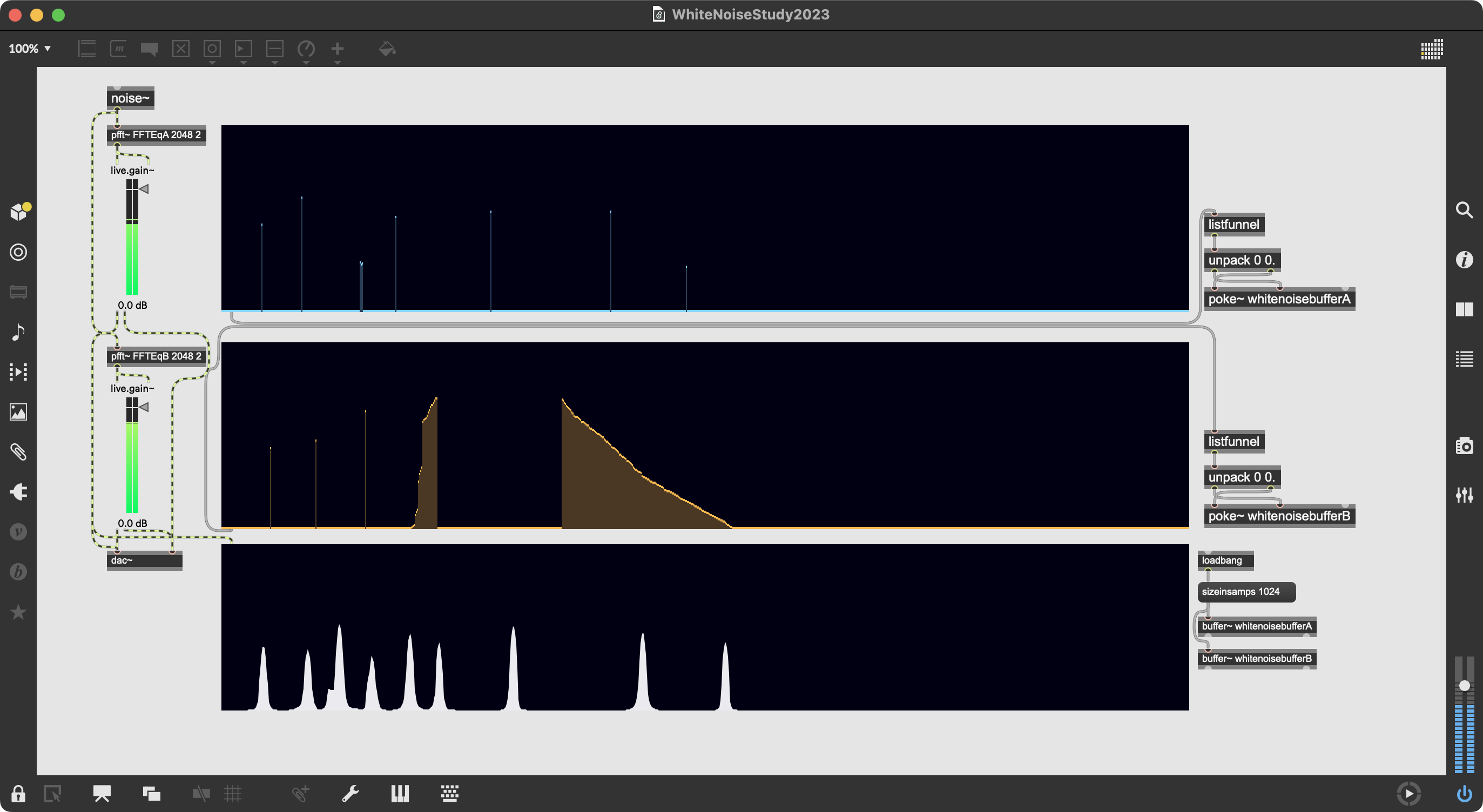
Download: Cycling '74 Max 8 Patch whitenoise.zip
Download: Ableton Max for Live Device White Noise Study
When I think about making noise, the methods are scattered, considering the difficulty of defining noise, so here I would like to consider how to make music while using the material scientifically called noise. I think the idea of scraping out white noise and making it into musical sounds, as Joji Yuasa did, is too abstract and difficult to understand without making the sound yourself, so I created maxpat so that you can understand it while making it.
If you do not yet have Max, please download it from the download link at the bottom of the page. You cannot edit the program without using the paid version, but you can run the distributed program and make sounds while changing the parameters.
The advantage of the method of sculpting musical sounds by processing noise in a subtractive-synthetic manner is that it is easy to create clusters. If we were to layer microtones in an additive synthesis manner, we would need a huge amount of sine wave oscillators to layer the sounds around the center frequency, but if we create clusters in a subtractive synthesis manner, we can achieve this with only one oscillator: white noise.
ノイズを作るということを考えると、ノイズの定義の難しさから考えても手法が散乱してしまうので、ここでは科学的にノイズと呼ばれる素材を使いながら音楽を作る方法を考えたいと思います。 湯浅譲二のようにホワイトノイズを削り出して楽音にするというアイデアも、自分で音を出してみなければ抽象的すぎて理解しにくいと思うので、作りながら理解できるようなmaxpatを作りました。
Maxをまだお持ちでない方はページの最下部にダウンロードリンクを貼っているのでダウンロードしてみてください。プログラムの編集は有料版を使わなければできませんが配布したプログラムを実行してパラメータを変化させながら音を出すことは可能です。
ノイズを減算合成的に加工し、楽音を削り出していく方法のメリットはクラスターを作りやすいということだと考えられます。 加算合成的に微分音を重ねて、中心周波数付近に音を無数に重ねようとしたら膨大な量のサイン波のオシレーターが必要になりますが、減算合成的な方法でクラスターを作れば、オシレーターはたった一つのホワイトノイズで実現が可能になります。
White Noise Sculpture
ホワイトノイズ彫刻
To explain roughly how WhiteNoiseStudy2023.maxpat works, first white noise is generated with the noise~ object as the sound source, and then it is analyzed by FFT. If you do not know what the term FFT means, it is not the essence of this topic, so you do not need to understand it just yet.
The two graphs above allow you to draw which frequencies of white noise to pass through, and the principle is that the calculations inside the pfft object cross-synthesize the graph and white noise, and do not resynthesize the sound at frequencies that are not included in either the graph or the source. As mentioned above, white noise is a wave that contains all frequencies uniformly.
Since this is an FFT filter that acts like a 1024-band graphic equalizer, it is possible to reproduce the
original white noise by setting all the values in the graph to their maximum values, but it is also possible
to draw curves with extreme characteristics and hear the filtered sound.
The graph can then be maxpat to compose and improvise electronic sounds by drawing the graph.
WhiteNoiseStudy2023.maxpatの大まかな仕組み説明すると、まず音源としてnoise~オブジェクトでホワイトノイズを生成し、それをFFT分析します。FFTという言葉の意味がわからない方は今回のトピックの本質ではないので、今はまだ理解しなくても大丈夫です。
上の2つグラフはホワイトノイズのどの周波数を通すかを描けるようになっており、pfftオブジェクト内部の計算でグラフとホワイトノイズのクロス合成を行い、グラフにも音源にも含まれていない周波数の音響は再合成(リシンセ)しないという原理になっています。 前述のとおり、ホワイトノイズとは全ての周波数を均一に含む波動です。
これは1024バンドのグラフィックイコライザーのような働きをするFFTフィルターであるため、グラフのすべての値を最大値にすることで元のホワイトノイズを再現することが可能ですが、極端な特性を持つカーブを描き、フィルタリングした音を聞くことも可能です。
そして、グラフを描くことで電子音響の作曲、即興演奏が可能なmaxpatになっています。
White Noise Sculpture with Modular Synth
モジュラーシンセを使ったホワイトノイズ彫刻
Noise and Music
ノイズと音楽
Eighty-five percent of the genetic diversity of the human population, now approaching 10 billion, is accounted for by people living on the African continent, and nearly 30 percent of the 7,000 or so languages are spoken in Africa. Considering music from a world where diversity is sometimes concentrated in a single region, one cannot help but imagine the diversity of the noise music scene.
As a musician, I even feel that most of the diversity in the field of music could be found in noise music. As a result, it might be interesting to ponder why so many diverse expressions have spread around the scene called noise. There may be various factors such as technical, cultural, and geographical reasons, and we may be able to learn more about the world through music. This time, we practiced experimenting with music using noise as a material, but if you look at noise music not as a material but as a culture, your musical experience may expand rapidly.
現在100億人に迫る人類の遺伝子の多様性の85パーセントはアフリカ大陸に住む人が占めており、7000ほどある言語の30%近くがアフリカで話されている言語です。多様性が一つの地域に集中するということもあるという世界から音楽を考えると、ノイズミュージックシーンの多様性を想像せずにはいられません。
音楽家である私から見ると音楽という分野の多様性の大半はノイズミュージックの中にある可能性すら感じてしまいます。結果として、なぜそれほど多様な表現がノイズと呼ばれるシーン周辺に広がったのかということに思いを馳せても面白いかもしれません。 技術的な理由、文化的な理由、地理的な理由、さまざまな要因があるでしょうし、音楽を通じてより深く世界を知ることができるかもしれません。 今回は素材としてノイズを使って音楽を試みる実践でしたが、素材としてのノイズではなく文化としてのノイズミュージックにも目を向けてみると皆さんの音楽経験は急速に広がるかもしれません。
Yoshihide Otomo
大友良英
Merzbow
メルツバウ
Reference
Curtis Roads. The Computer Music Tutorial. MIT Press https://mitpress.mit.edu/9780262680820/the-computer-music-tutorial/
Charles Dodge. Computer Music: Synthesis, Composition, and Performance. Schirmer Books https://amzn.to/463ehCu
Kim Bjørn. PATCH TWEAK. Bjooks https://bjooks.com/products/patch-tweak-exploring-modular-synthesis
Dennis DeSantis. Making Music Creative Strategies for Electronic Music Producers. Ableton https://makingmusic.ableton.com

